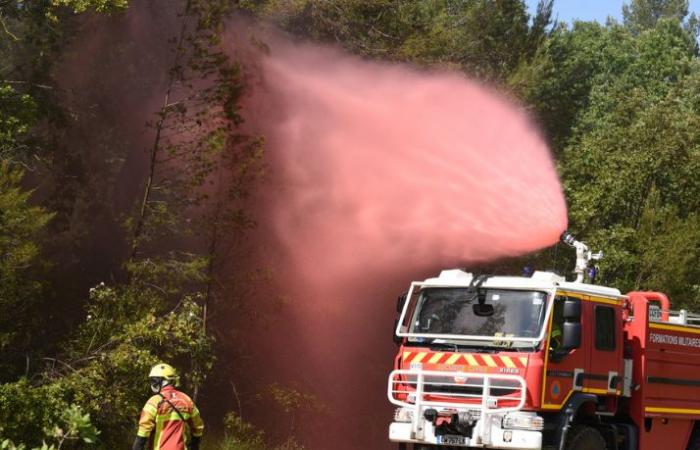At the Entente Valabre in Gardanne, several SDIS and fire prevention stakeholders gathered for a conference to discuss the preservation of this resource, essential for fighting forest fires. A look back at a very instructive day.
You just have to know the adage: “To stop a fire, you need a glass of water the first second, a bucket the first minute and… a ton of water after 10 minutes” to understand how essential the issue of water resources is in the fight against forest fires.
Climate change and water resources
On June 4, the conference opened with a painful reminder of the progression of climate change. Hélène Correa, Head of the Forecasting and Climatology department, South-East Region sector at Météo France, emphasizes that the south of France is warming up faster than the rest of the country. We have already recorded an increase of +1.8° since 1959. According to a pessimistic scenario, it should reach +2.3° in 2050, with an increase in heat waves and so-called tropical nights (i.e. with a temperature that does not drop below 20°). To give you an idea, at this rate after 2050, we will consider the scorching summer of 2003 as cool. A climate change which will of course have an impact on the vegetation, which will dry out, on the availability of water resources, with shorter and more violent rainy episodes, on the temperature and the state of the soil.
Good news however, in the southern region the water architects have worked miracles. From the Romans to Adam de Crapone and with the Canal de Provence, vast reserves and networks have been built, making it possible today to secure the resource for decades. However, savings are essential for all water users, whether individuals, farmers, industrialists and even firefighters. To put this subject on the table, neighboring SDIS came to present the solutions implemented in their territory.
Take water where it is available
In the Pyrénées Orientales, several municipalities are already experiencing shortages of drinking water, and the list will inevitably grow in the weeks and months to come. A context that creates tensions between water users, and where the search for raw (non-drinkable) water is essential. The SDIS 66, represented at the conference by Lieutenant-Colonel Trani, has thus become a master in the art of diversifying the resource. Campsites and aquatic centers, required to regularly empty their swimming pools and other sanitary facilities, now store the precious resource in plastic tarpaulins for some of them. In conjunction with the Chamber of Agriculture, winegrowers make their empty tanks available to store water. In ski resorts, such as Font-Romeu, devices have been installed on snow cannons to be able to connect the pumps and draw on these resources, unused during the summer season.
The issue of reusing treated wastewater remains complex, with limited storage times and the need to rinse the equipment with clean water, as is the case for salt water. Because in parallel with the diversification of the resource, it is also the equipment that is required to evolve, with the use of high-pressure fire hoses, the use of retardants and foaming compounds or the deployment of pumps adapted to collect water in all environments, regardless of the topographical specificities.
Fight fire with fire
Prescribed burning, counter-fire and tactical burning are other ways to prevent or fight fires, presented during the conference by Commander Jérôme Jallet of SDIS 30 (Gard). Prescribed burning, an ancestral practice well known to old shepherds, consists of taking advantage of the humid conditions of winter to clear brush by fire, and thus eliminate the vegetation that could be used as fuel once summer comes. This technique also allows the youngest firefighters to learn the trade in a secure environment.
In the event of a proven fire outbreak, counter fire consists of lighting a fire, from a sheltered area such as a path, in front of the initial fire so that it comes to meet it. The backfire reduces the available fuel, which considerably reduces the power of the fire which no longer has material on which to progress. Finally, tactical burning is used in particular to attack the edge of the fire. When it develops in a sawtooth pattern, on reliefs for example, strategic burning allows it to be realigned to facilitate the work of firefighters.
The little-known role of forest firefighters
FORCE 06, in the Alpes-Maritimes, brings together several forest firefighters. They are responsible for maintaining DFCI (Forest Fire Defense) infrastructures and carry out prevention and maintenance actions in the forest area. Situation diagnostics, assessment and causes of fires, clearing, monitoring of water reserves, they intervene on the ground to prune and create support zones for the fight by clearing spaces in the massifs likely to slow the progression of a fire.
The most obvious way to save water is to prevent fires from starting altogether. And the ultimate way to help firefighters is for all citizens to do their part: 9 out of 10 forest fires are of human origin, half of which are due to carelessness. Cigarette butts thrown away, barbecues held near vegetation, fuel stored too close to a home, failure to comply with restrictions on access to flowerbeds… Let’s change our behavior, the firefighters and nature will thank us!
Witness a fire? Contact 18 or 112 immediately
Respect the rules for the common good. For those who are most refractory to the laws, financial sanctions are applied:
– A campfire or a cigarette: €135 fine
– Lack of clearing (50 meters around your home): 135€ fine
– Off-road driving: 1500€ fine
– Responsibility for the start of a fire, even unintentional: €3,500 fine and 6 months in prison.
The Entente Valabre, partner of the Southern Region
Since 1963, the Entente Valabre has been working on issues related to fires. It was following the year 1962, devastating for the forests, that this public establishment was created. A pioneer and visionary in the means of struggle, the Entente invested in the first Catalina (water bomber planes). The Entente Valabre is fire prevention but also research and development, the development of new technologies and geomatics solutions.
SOURCE: Southern Region.
- -





